Over 80 Thousand Tripitaka Koreana
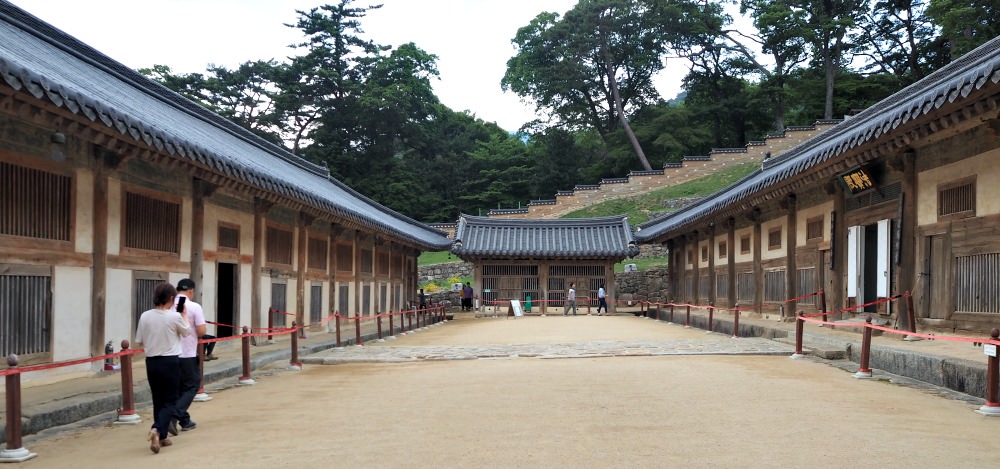 Three wooden buildings housing the over 80 thousand Tripitaka Koreana woodblocks of Buddhist scriptures
Three wooden buildings housing the over 80 thousand Tripitaka Koreana woodblocks of Buddhist scripturesIntroduction
The 80 thousand Tripitaka Koreana is one of the greatest treasures by Buddhism religion in South Korea. It is housed at the Haeinsa Temple in South Gyeongsang province and has been registered as a UNESCO World Heritage Site.
The wooden printing blocks are arranged in 80,000 bundles that can be read from right-to-left. Each bundle consists of three to five wooden blocks with Buddhist scriptures carved onto them.
They have been stored in Haeinsa since 1398 and have been kept safe despite natural disasters, wars and other threats.
The Tripitaka Koreana is an important cultural heritage that symbolizes the spirit of Buddhism and its devotion to sharing wisdom with others. It is a testament to Korea’s long history of religious faith and culture. It also serves as a reminder of the importance of education and teaching.
The contents of the Tripitaka Koreana are studied by various scholars, who strive to understand its vast knowledge and wisdom. In addition, it is also an invaluable source of insight for people all over the world who seek spiritual enlightenment.
The Tripitaka Koreana exemplifies Korea’s commitment to preserving its culture and religious beliefs. It is a symbol of Korea’s dedication to the preservation of knowledge, wisdom, and understanding.
Its importance continues to be appreciated in our modern world, as it serves as a reminder that knowledge is essential for progress and enlightenment.
The Tripitaka Koreana has been inscribed on UNESCO's Memory of the World Register since 2007, in recognition of its cultural significance. It is an important part of Korean heritage and culture, and it serves as a reminder to us all that knowledge should be shared and preserved for generations to come.
The Tripitaka Koreana has been widely acclaimed by scholars across the world, as well as those who appreciate its historical and cultural significance. It is a valuable resource for understanding Korean culture, religion, and philosophy.
So the next time you visit South Korea, make sure to pay a visit to this amazing collection! You are sure to be impressed by its grandeur and beauty. Thank you for taking the time to read about the Tripitaka Koreana!
80 thousand tripitaka koreana
The over 80 thousand Tripitaka Koreana or Palman Daejanggyeong is a library of Buddhist scriptures inscribed on woodblocks.
The woodblocks, exactly 81,258 printing blocks,[1] are being safely housed in Haeinsa Temple, which is in the famous Gayasan National Park area.
TREASURES: The Tripitaka Koreana is enlisted in the UNESCO Memory of the World Register in 2007, and was designated a National Treasure of South Korea in 1962.
I have visited the buildings where these Buddhist canons are being kept as my second purpose of visiting the famous Haeinsa Temple.
It was early summer when I visited the site, and so it was just a fantastic time to explore the Gayasan National Park and enjoy the lush forest covering the rocky peaks below the white clouds and blue skies.
Some Interesting Details
The Tripitaka, a traditional term for the Buddhist scriptures, is a collection of canon carved onto over eighty thousand wooden printing blocks in the 13th century by Buddhist monks.
Here are some details [2]:
- it has 52,330,152 characters (Hanja script)
- it has 6568 volumes and 1496 titles
- each wood block is around 24 cm in height, 70 cm in length; 2.6 to 4 cm thick and weighs from 3 to 4 kgs each
- weigh 280 tons in total
TRIVIA: It will reach 2.74 km when stacked and as tall as Baekdusan (Mountain). It will be 60 km long if lined up.
Much of the contents include Buddhist treatises, laws, canon, travelogues, Sanskrit and Chinese dictionaries, as well as biographies of prominent Buddhist monks and nuns who were part of the labor and life surrounding the establishment of the temple site.
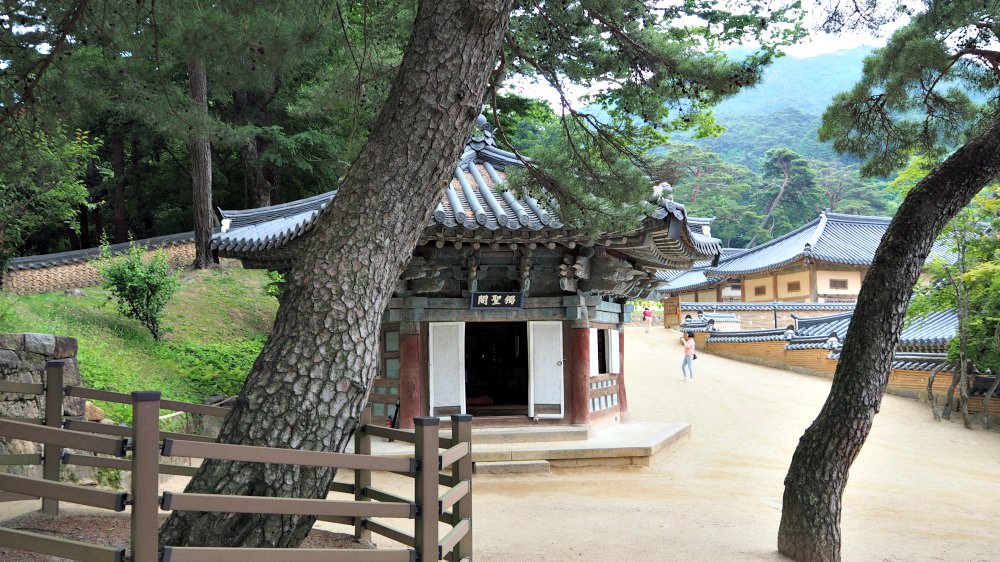 The path leading to the buildings that house the over 80 thousand Tripitaka Koreana canon
The path leading to the buildings that house the over 80 thousand Tripitaka Koreana canon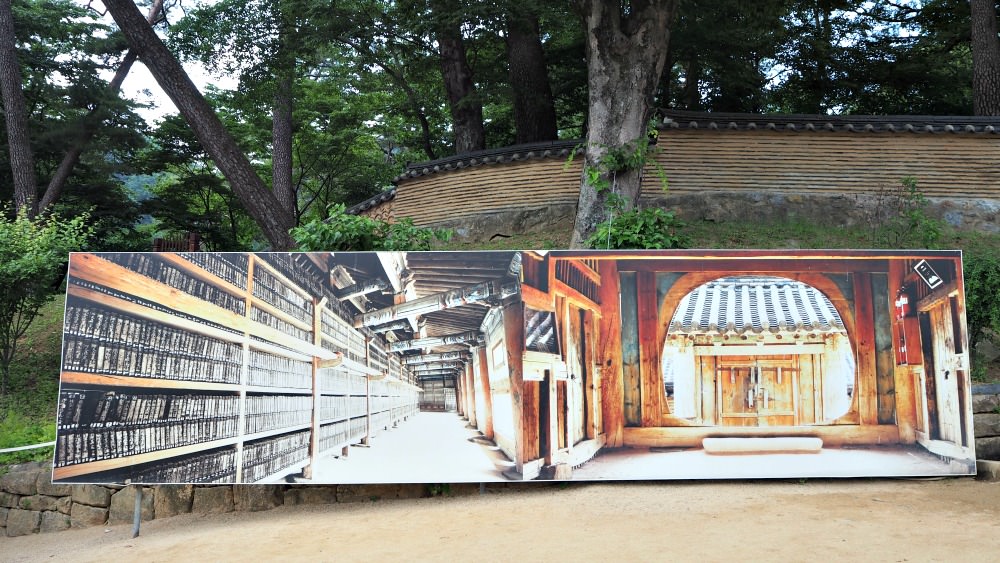 Photo of the room that contains the woodblocks
Photo of the room that contains the woodblocks A copy of the woodblock in front of the buildings that house the scriptures
A copy of the woodblock in front of the buildings that house the scripturesbrief historical background
The over 80 thousand Tripitaka Koreana (originally called Goryeo Tripitaka) labor began in around 1011 and completed around 6,000 volumes.
However, they got destroyed by fire during the Mongol invasion in the 13th century as the Goryeo Kingdom moved to Ganghwa Island.
King Gojong ordered the recreation of the Tripitaka which began in 1237 and completed twelve years later with support from monks of Seon (Zen) and Gyo Buddhism schools.
The massive labor, efforts, and financial resources put into this work is incomparable.
Preservation of Tripitaka Korea
They say that Haeinsa Temple's four buildings, which houses the Palman Daejanggyeong, are scientifically designed to preserve the woodblocks from decay.
The Tripitaka woodblocks are in good condition for over 750 years now.
to ensure that good quality results of the labor is obtained, each block is made of Birchwood and treated with traditional methods.
each block of wood was soaked in seawater, cut, and then boiled again in saltwater.
then, each block underwent the process of aeration (drying it under the shade with sufficient flow of the wind).
After the carving job, the block was polished with poisonous anti-insect lacquer then placed in a metal frame to prevent warping. (Source: Tripitaka Koreana, Wikipedia).
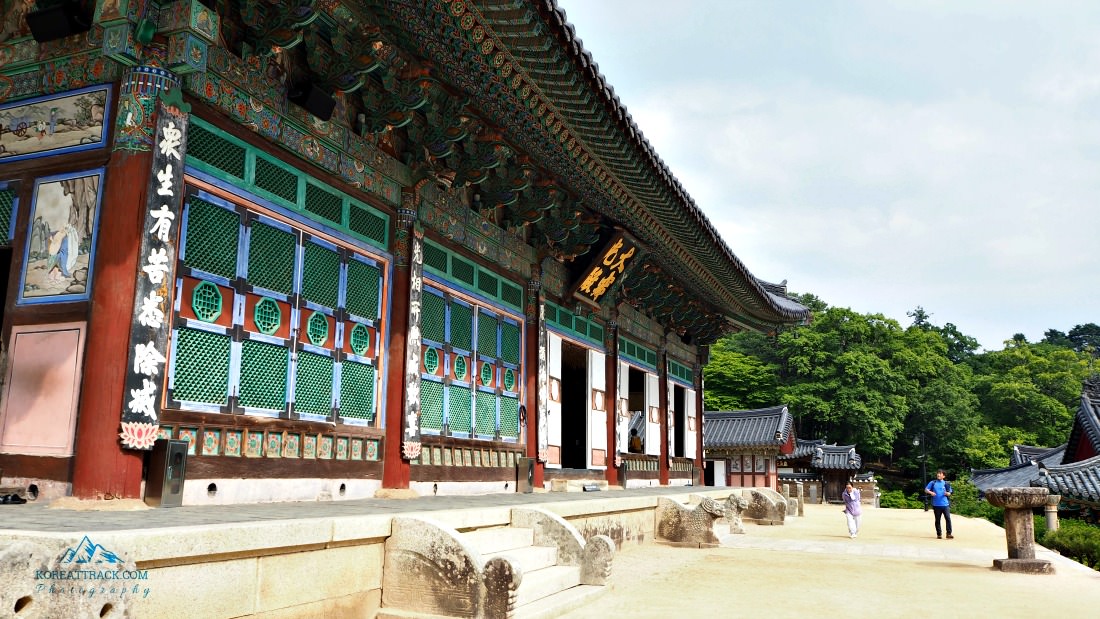 The Great Hall of Tranquil Light
The Great Hall of Tranquil Light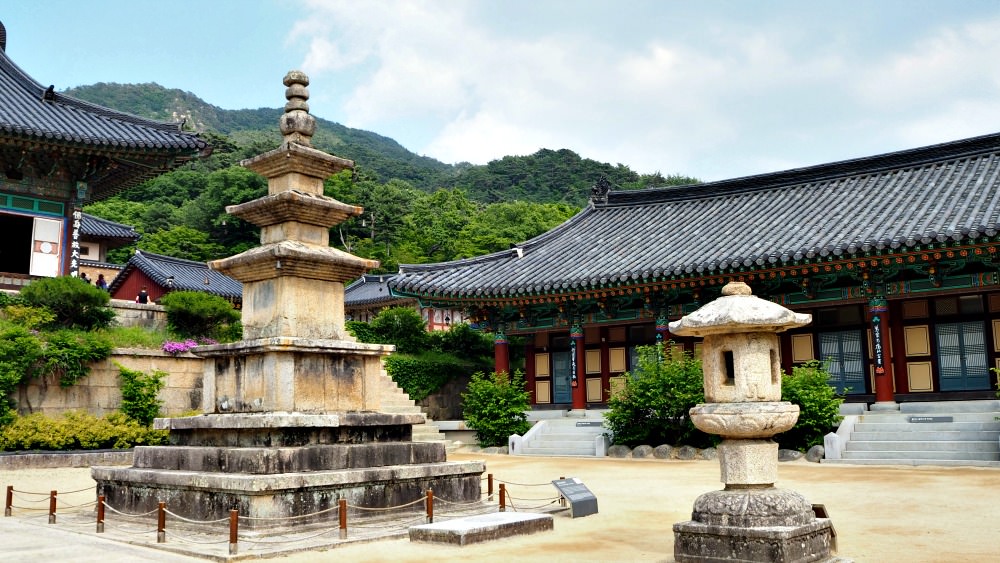 Ancient stone pagoda and stone lantern in front of Haeinsa Temple. Right above the temple area is where the 80 thousand Tripitaka Koreana Buddhist woodblock scriptures are located.
Ancient stone pagoda and stone lantern in front of Haeinsa Temple. Right above the temple area is where the 80 thousand Tripitaka Koreana Buddhist woodblock scriptures are located.Studies on Tripitaka Koreana
Scholarly studies and research about the text of the Buddhist canon are ongoing.
You can find near the entrance area of Haeinsa Temple the research building specializing the Tripitaka. (I haven't been there and so it would be my next mission next time around).
Also, you will see some displays and descriptions about 8 thousand Tripitaka Koreana in a museum and park just a few kilometers from the temple area, which is called the Theme Park of the Tripitaka Koreana.
My Impressions & Thoughts
I was very excited and was expecting much to see the 80 thousand Tripitaka Koreana blocks before my eyes.
But it did not happen. The policy was stringent that no one is allowed to go inside the four buildings where the scriptures are being kept.
You could only see a photo near the entrance area.
I could only see from the small openings of each building the sides of the woodblocks of the Tripitaka. Not a word or Hanja is visible.
To prove to myself (and others) that I've been there, I asked the staff if I could take some photos (because there was a sign that photography is not allowed).
Yes, visitors are allowed to take photos (pictures), selfies, groupies, in the ground surrounded by the four buildings.
I am hoping that progress will be made and that these (or some of them at least) blocks will be moved to a more controlled and safe place, such as museums with protective glass, where I could see them with my naked eyes.
My only worry at present includes two points: decay through time and fire.
First, although I believe that the treatment of the woodblocks is effective, through the time, they will slowly get decayed, especially with the worsening weather conditions and climate changes.
The blocks are being kept in the buildings that allow all elements (wind, temperature, moisture, dust, insects, etc.) to get or pass through the small openings of each building.
Second, my worst worry--if something wrong happens--fire! Probably, nobody would start it but since mountain or forest fires are becoming more frequent in Korea, if not all over the world, these work of art and religious treasure could be in danger of getting lost.
My idea? Keep them safer with all sorts of 'disaster-proof' and fire-proof facilities. Yes, it will be costly, but worth spending.
 Fantastic rock formations in Gayasan National Park
Fantastic rock formations in Gayasan National ParkGetting to Haeinsa Temple
I took a bus from Incheon International Airport (T1) to Daegu Seobo Bus Terminal. Then I took another bus from that same terminal to Haeinsa Temple.
All bus terminals in Seoul and cities, provinces, and places in the country have buses that travel to Daegu Seobo Terminal.
But, more buses travel to Dong Daegu Intercity Bus Terminal.
So, you can get there first then take a subway (or taxi) to Daegu Seobo Terminal for another bus ride, which takes around 1 hour (and approximately 10 mins.) to Haeinsa Bus Stop from where you just walk towards the temple and find the 80 thousand Tripitaka Koreana.
Please, drop me a line if you need some detailed guidance :).
More Exciting Sites to Explore
Of course, Haeinsa Temple site or the 80 thousand Tripitaka Koreana are not the only attractions and places worth spending your holiday, time, or resources.
Haeinsa Temple was my second (eh, almost the first, maybe half!) reason or destination during my travel there.
Hiking the Gayasan National Park and getting to the highest peak(s) (Chilbulbong and Sangwangbong) were my intentions. Yes, did it!
So, briefly, these are some of the sites you can explore...
- Theme Park of Tripitaka Koreana
- Hiking the Sorigil to Haeinsa Temple
- Gilsangam Hermitage (Temple)
- Nakhwadam Pond (stream pool)
- Ancient Tombs in Okjeon
- Hapcheon Museum (1,500-year relics)
- Birthplace of Nammyeong Cho Shik (16th c. scholar)
- Noeryeongjeon Pavilion and Yongam School
- Hapcheon Dam Water Museum
- Chunguisa Temple (for the dead volunteer soldiers)
- Hwangmae Plain (known for Royal Azaleas)
- Monsanjae ("the mountain with a pond)
 Haeinsa-Sorigil Hiking Trail
Haeinsa-Sorigil Hiking TrailStaying in Hapcheon Gayasan
Gayasan National Park area is a serene, verdant, and less populated area. But you can find various places and facilities for your stay during your visit.
Since I was not prepared to camp out that time, I stayed in a hotel near the entrance of the hiking trail (Baekundong Camping Site).
Some useful information...
- Travel Hotline: +82-2-1330 (English, Korean, Japanese, Chinese)
- For more info: +82-55-930-8000
- Homepage: english.knps.or.kr (Korean, English, Japanese, Chinese)
Alternatively, you can safely use this travel guide's official accommodation, online booking providers. Use the Search Box located on the right side of each page.
Overall, it was a memorable and enlightening experience at Haeins Temple's 80 thousand Tripitaka Koreana. I will never doubt revisiting the place.
However, next time, I will plan properly and for longer days to discover more and enjoy better!
Thanks for reading through this article, and I hope this helps. I also wish you have wonderful travels!
- Home
- Korean UNESCO Heritage Sites
- 80 Thousand Tripitaka Koreana
Get Exciting Activities
Book one of our exciting activities today to experience the thrill of a lifetime! Take advantage of this opportunity and secure your spot in advance.
Hotel Map Guide
Find your affordable, accessible, and comfortable hotel in Seoul at Agoda.Com. See the hotel map below...
Hotel Booking Guide
Find affordable and amazing hotels on Agoda.com using the search box below. Book now to enjoy great discounts and save!


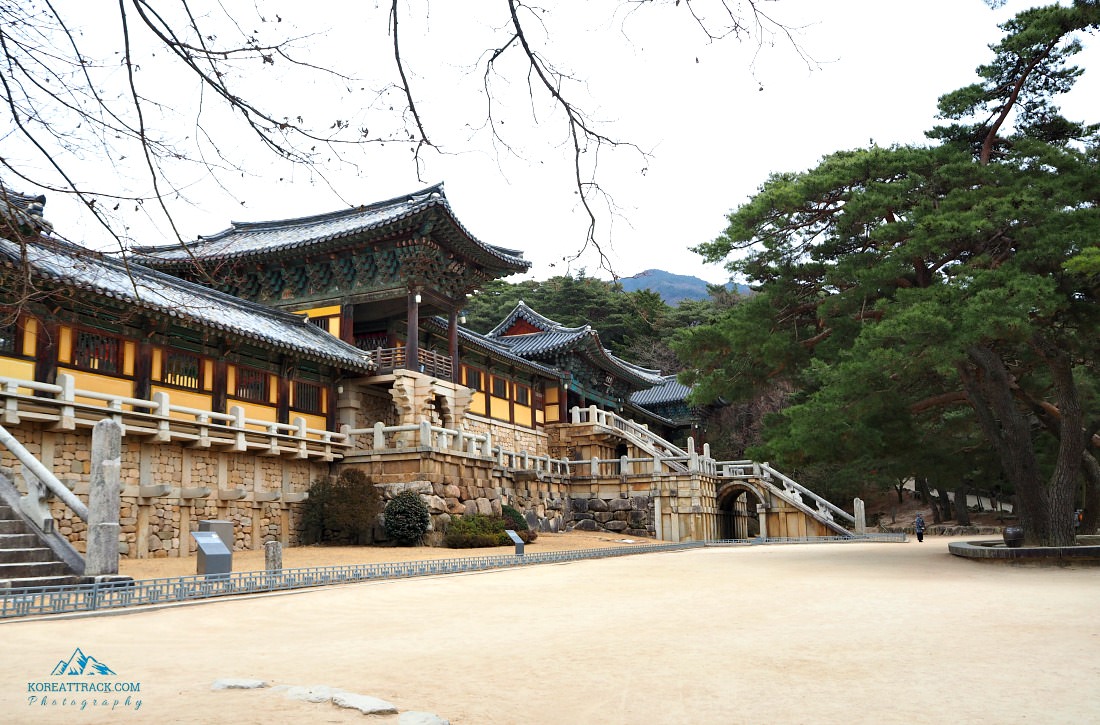




New! Comments
What do you think about this page? Leave me a comment in the box below.